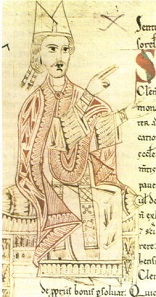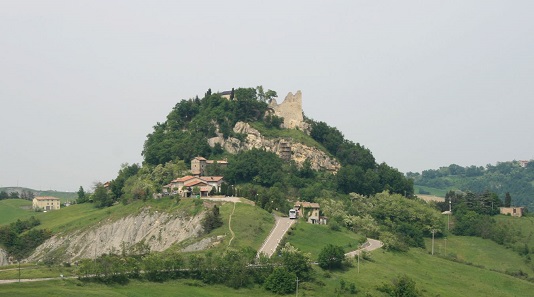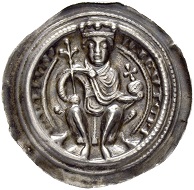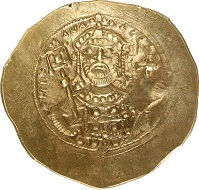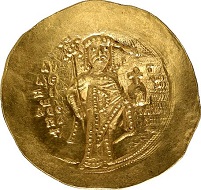translated by Katja Protsiva
Under Robert Guiscard’s brother Roger, orthodox Christians and Muslims could live in peace side by side in Sicily. Also Robert’s subjects in Lower Italy appreciated their liberties. But how could the gentlemen of Southern Italy permanently secure their sovereignty in order to protect the active tolerance from the aggressive claim to power of the Roman Church? To be able to understand that, we have to look again at the history of the church.
Pope Gregory VII in a manuscript from the 11th century.
Church policy part 3
In 1073, Hildebrand of Sovana was elected pope. As Gregory VII, he was supposed to carry the church reform to extremes by demanding that earthly power should be subordinated to clerical power. Naturally, no earthly ruler could or wanted to accept such a manifestation of the church reform – and Robert Guiscard made no exception there.
Gregory excommunicated the duke of Apulia, Calabria and Sicily in 1074, already one year after his inauguration. The reason for that was of very minor importance and there were no practical consequences of this clerical measure whatsoever. So Gregory suffered total defeat on the Southern Italian stage. Whereas his first excommunication of the German emperor, Heinrich IV in 1076, became an unexpected success. Obviously not because the German rulers were so much more devout than their colleagues from Lower Italy. Heinrich IV just did not have the military strength to counter an insurgency – and the emperor’s excommunication made an excellent excuse for the German rulers.
Today, the Canossa Castle in Emilia-Romagna is a ruin. Photo: Franz Xaver / CC BY-SA 3.0
So Heinrich made the brilliant move of forcing Gregory to withdraw the excommunication in Canossa and return to Rome. With that, Heinrich won the most important thing – time.
Heinrich IV. Frankfurt, royal mint. Bracteate. Sincona 43 (2017), no. 2094.
Already four years later, Heinrich’s regency was secure again and he had the military situation under control – at least in Germany. So it was foreseeable that he would soon also come to Italy. Gregory had to expect banishment or worse. An unpleasant situation for the militant pope. He urgently needed a patron. But there were not so many available. Who would dare to oppose the emperor? That only left Robert Guiscard who in turn had to fear that the German emperor would claim Lower Italy as part of the Roman Empire.
That way, Robert promised the pope military support for the absolution and the approval as independent duke of Campania, Apulia and Sicily. On June 29, 1080 Robert took the vassal’s oath. Four days earlier, an imperial council in Brixen had degraded Gregory as pope and appointed a new one. This constellation – on one side, the pope and the Norman duke and on the other side, the emperor and the antipope – became a political constant for almost a century. On account of that, Robert, Roger and their successors enjoyed the freedom of not having to tolerate a papal legate in Sicily, appoint the bishops themselves and basically having a proprietary church.
Michael VII, 1071-1078. Histamenon. Sear 1868. From auction Gorny & Mosch 176 (2009), 2777.
Reaching for the stars
However, we should not assume, that Robert saw this alliance as a serious obligation. He had more important things to do than protecting the pope, at least to his mind. Because the situation in the Byzantine Empire had changed a lot since 1071. Romanos IV Diogenes had been replaced by Michael VII Dukas, an educated and sophisticated man who lacked military experience. Michael was born in 1059 and he was the oldest son of Konstantin X Dukas. Since he was too young to take over for him when his father died in 1067, his mother married the accomplished military man Romanos. After his defining defeat in Manzikert, the 12-year-old Michael had to take over the rule. Under his control, the Byzantine Empire lost one territory after the other. There were many revolts in the Empire. His subjects gave him the sobriquet “Parapinakes“ (= minus one quarter), because the price for crop had risen so much under his control, that one could only buy three-quarters of wheat for the same amount of money. So Michael was desperately looking for support and was obsessed with finding matrimony with the Norman upstart. Michael had to improve his offer three times before Robert even bothered to reply. Finally, they agreed that one of Robert’s daughters should marry the heir to the throne of the Byzantine Empire for a great amount of money. Sicily’s ruler promised the Byzantine emperor military support in return and sent his daughter to Constantinople. One needs to savor this slowly: The son of a minor lord of a castle from the middle of nowhere graciously deigned to let the Byzantine emperor’s son marry his daughter for an adequate amount of money. At no point in history it becomes more apparent what a long way Robert Guiscard had come.
Alexios I Komnenos, 1081-1118. Hyperpyron. Sear 1924. From Gorny & Mosch auction 176 (2009), 2782.
But already in 1078, the matter resolved itself: Michael VII was overturned and put into a monastery together with his son and daughter-in-law. A wonderful reason for Robert to start a war. Why bother, that even Michael’s successor was already dethroned! The new emperor, Alexios I Komnenos, made promises of returning the Norman bride unharmed to the father but Robert was not interested in that at all. He had enough daughters. Whereas in Constantinople, his beloved Helena made an impressive excuse to start a war. Robert did not miss this opportunity. At the age of 64, he headed off to conquer the Byzantine Empire.
Robert Guiscard, 1077-1085. Doppio Follaro. Cappelli 36 (Dominazione Capuana). From Gorny & Mosch auction 123 (2003), 3761.
His plan already failed in Dyrrachium, the Italian Durazzo. Robert “the Cunning” was not cunning enough to realize how many enemies he had made by then. He was not only fighting against the Byzantine Empire but also against the rising trading power Venice, who, under no circumstances, wanted to leave the Strait of Otranto to the Normans. And when the emperor also sent agents to Apulia, in order to prompt the unsettled aristocrats to start a riot against their absent ruler, Robert’s only choice was to return to his country and try to save what could be saved. The attack on the Byzantine imperial throne was over for now. But Robert wanted to try again just a couple of years later.
In the next part, you can read what difficulties Robert had to face in Italy on all fronts.
Here, you find all the parts of the series.
And if you want to see more pictures of Sicily, we recommend you our series “Sicily in full bloom”.



